|
FanFile MAGAZINE
|
FanFile MAGAZINE


|
The grass is now greener….
It’s the last thing you ever thought of…turf quality at high school football stadiums. Luckily, Ted Mercer did think of it…and has made a living out keeping it green at a field near you.
[
Read more
] |
|
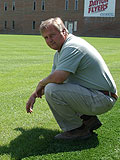 |

The Best…!
The FanFile ranks the area’s best playing surfaces through the eyes of coaches, players, and Ted Mercer, of the Mercer Group.
[
Read more ] |
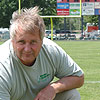 |
Grass killers….
If…you want to take better care of your own facility, here’s some things you might want to know about better turf management, courtesy of the experts.
[
Read more ] |
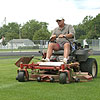 |
©2002 FanFile.net, All Rights Reservered. |
|
 |
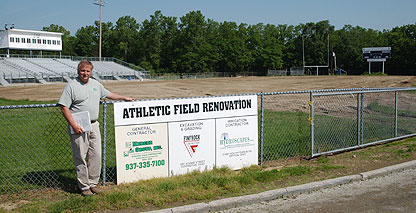 |
Ted Mercer, President of the Mercer Group, Inc., at Valley View High School's stadium renovation site. |
|
|
It’s the last thing you ever thought of…turf quality at high school football stadiums. Luckily, Ted Mercer did think of it…and has made a living out keeping it green at a field near you.
It’s the last thing you think of when you go to a high school football game. The turf, that is.
If there’s grass and it’s green, we take it for granted. If there isn’t…it’s understandable. Everyone knows, or assumes, that turf management costs money and in the pecking order of high school budgets…that’s an expense that comes way down the list.
It’s not a matter of not being important. For the sake of safety to athletes, the playing surfaces of high school fields are very important; and thanks to the efforts of people like Ted Mercer, the future of turf on Friday nights is brighter…make that
greener…than ever before.
Mercer heads up a turf management company in Troy, understandably enough, called the Mercer Group…a business that specializes in the installation and maintenance of sports surfaces in the Miami Valley, the state of Ohio…and yes, they get some calls
from around the country, as well. In particular, they do a lot of high school work. It’s an entrepreneurial opportunity that Mercer could see coming…years ago.
“I think there’s more attention to turf now than ever before…for matters of safety to the kids… and because the turf industry has developed so many new products that make better grass an affordable reality,” said Mercer recently while overseeing the
installation of Valley View High School’s new field. “Where our work used to be primarily a matter of maintenance, now we’re doing more of the heavy work because we have the equipment and the clients do their own maintenance. There’s also better access to the new products, and
better marketing…letting schools know what they need and where they can get it. We still get called in when there’s a disease or systemic issue that’s out of their control, but a lot of field maintenance work is being done in-house now.”
High school stadiums have come a long way in the past 30 years. Even some of the state’s more historic playing fields have seen their share of hardships and ridiculous oversights. Veteran Ironton Tiger fan, Bill Corn, remembers the days when that
city’s historic Tank Stadium…the original home of the NFL’s Ironton Tanks… was used as a school parking lot.
“For years, they parked the district school buses on the football field during the summer,” says Corn. “They just left them there all summer…til August when they pulled them out for maintenance. Whatever grass was there was what they played on in
September and then there were all those tire ruts from the buses. We had the only high school field in the state where you had to watch out for the oil slicks.”
More locally, Wertz Stadium in Piqua really suffered in its last years as the home of Indians’ football from too much traffic…and Sidney’s Julia Lamb Field is famous for being bare between the hash marks after the 5th week of the season.
Today, the attention given to many high school facilities, compared to the old days, borders on obsession. Mercer points beyond better products…and to individuals and groups who’ve taken it upon themselves to upgrade and maintain their facilities.
“There’s no question that people take more pride in their facilities than they used to,” says Mercer. “I give a lot of credit to what Bob Huelsman has done at Covington. I think the renovation of the Troy stadium a few years ago led to a tremendous
improvement in that playing field…and new stadiums like Piqua’s has certainly raised awareness. There’s a lot of individuals and volunteers out there who’ve taken it upon themselves to oversee better maintenance of their facilities.” |
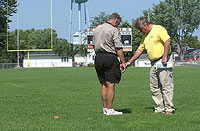 |
Good surfaces like Covington's Smith Field, require periodic check-ups. |
|
|
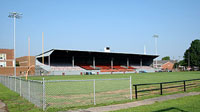 |
Ironton's historic Tanks' Stadium…where they once parked the district's school buses. |
|
With the help of the Mercer group?
“In some cases, yes,” continues Mercer. “For the most part, we get them off on the right foot and then do periodic inspections to make sure they stay on course. The problem is…and this is just human nature…so many people fail to keep up
the correct maintenance on a playing field until it’s time to play on it. They need proper nutrition, like anything else that grows, in timely installments…and proper and timely mowing is a must. By the time they call us in August it might be too late. A good playing
surface must be maintained properly from the time it greens up in the spring ‘til you’re through playing on it in November.”
Mercer points to many improvements in products that allow for better facility management in-house.
“The products available now are so much better…beginning with grass seed. Because of the stress put on playing fields now through soccer and football, there are more durable grasses now than the old traditional Kentucky bluegrass. The
agronomy industry has stepped up in that respect. Fertilizers…you now have turf products that have the built-in weed and insecticide support that allows you to grow better, stronger, healthier turf. You give someone these products who has an interest in doing a good
job and they’ll come up with some outstanding results.”
But never without that human element…people who take a lot of pride in the finished product they roll out on Friday night.
“What they do in Covington is just outstanding,” smiles Mercer. “Not only do they have the most plush surface in the area…they have the most artistic, as well. They paint the pirate head in the middle of the field and really do the yard
markers and end zones up right. It looks like the best of most college fields. Again, this stems from the pride Bob (Huelsman) initiated years ago in the Covington facilities and the support of some great volunteers who want to keep it that way.”
Being green and weed-free is one thing, but what other elements go into making a good playing surface for soccer and football ?
“Well, a good grass surface is important…but there’s also the factor of the speed of that surface as well. I think a lot of people would say that the new Troy surface is the best in that respect because it’s very fast as well as
beautiful. When they redid that field a few years ago we put in a version of the prescription athletic turf…a sand-based, amended sub-surface, with a rye surface that can be kept shorter and is easy to grow.”
Mercer’s group oversaw that project, which he credits for an awareness of better turf in a number of area districts.
“There’s no question the Troy project probably sparked a lot of awareness,” he nods, “and
you’re seeing the impact at a number of schools.”
Some of the more notable upgrades that have been made are Versailles, Valley View, Tipp City, Piqua, and of course, Troy Christian’s new facility that opened last fall. All have benefited from the technological advancements that Mercer
mentioned…many from Mercer himself.
“It’s gratifying to see so many people working to have better surfaces for their kids,” he laughs. “Long as they do, I guess I’ll always have a job.”
Sure thing. Long as they don’t park the buses on the football field!
The FanFile
|
|
|
|
 |
The FanFile ranks the area’s best playing surfaces through the eyes of coaches, players, and Ted Mercer, of the Mercer Group. Our thanks to those who took the time to share their opinions! |
|
1. Troy Memorial Stadium…
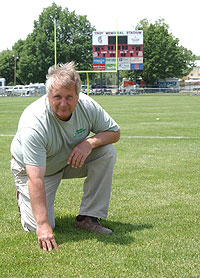 |
The turf at Troy's Memorial Stadium rates as the area's best.
|
|
Troy’s surface gets the overall nod for its combination of turf quality…and speed. It, like many other facilities in the area, gets an incredible amount of traffic, including high school football, boys and girls soccer, and it’s a
regular site for OHSAA playoff games. It’s secret? A financially feasible version of the prescription athletic turf concept featured in many more prominent sports edifices across the country. Memorial Stadium features a turf that can be cut shorter, drains superbly and
provides the smoothest playing surface of any high school facility in the area. State-of-the-art irrigation and constant supervision of the Mercer Group keeps this surface looking great all year long. |
|
2. Ed Smith Field (Covington)…
We don’t know who Ed Smith was (as in Ed Smith Field), but he certainly has to be smiling at the reputation for the grass surface of his football field. It’s so nice, and so plush, one league coach described it as being like a trip to the Super Bowl for
his kids…just to get to play on Covington’s spectacular grass. The Buccs do it up right, with great graphics and color in their decoration of the surface, but a critic points to the fact that it’s very slow to play on. “That field is always worth a step to Covington when
they’re playing a team with a quick running back,” says a rival coach. “But hey, it’s a beauty.” The fact that there’s no soccer at Covington keeps this field in peak condition every night of the season…rain or shine! |
|
3. Troy Christian…
The Eagles’ brand-new facility opened in 2002 with a custom-sod playing surface that’s beautiful to look at, but according to Mercer, has yet to see its best days. “It’s a field that’s so new it hasn’t had time to mature. Typically it takes about three
years. It’s a nice surface, though, with a good grade (crown) and sub-surface. It should be good for years to come.” |
|
4. Valley View…
Valley View has done it up right…with a total renovation of their football facility, complete with a new amended sub-surface, proper drainage and bluegrass sod. “That’s a field that will be good for a long time because they’ve incorporated all the
variables that will make it easy to keep…a sand base, drainage and they don’t play soccer on it,” says Mercer. “It’ll be a beauty come September.” |
|
5. Tipp City…
Tipp’s ballyard in the park has come a long way in recent years…again, a result of better management. “It used to be when you came into Tipp on a rainy night it was a greasy, slick mess,” says a rival coach. “No more…they’ve really fixed it up.” Others
comment that it has too much crown, but for overall playability, it’s a very nice surface. |
|
6. Piqua…
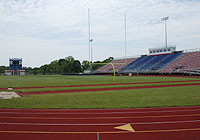 |
The turf at Piqua's new Alexander Stadium has yet to mature as a premier playing surface.
|
|
One comment heard about Alexander Stadium when it opened was, “…hope the playing surface matches the amenities.” One of the state’s newest and best high school facilities, the playing surface of Purk Field is a mixture of rye, fescue
and blue grasses…that while durable, makes for a somewhat uneven and indifferent surface. “It looks better from the stands than it does if you’re on the field,” comments one league rival, “but it’s better than ours…and most of the others we play on.” Ironically, the old
Wertz Stadium features one of the area’s best turf surfaces. Dedicated solely to soccer now, it has benefited from the Mercer touch. “It gets a more realistic amount of traffic than it used to and the rye surface has really performed well,” says Mercer. “It looks good
and plays good.”
The FanFile
|
|
|
If…you want to take better care of your own facility, here’s some things you might want to know about better turf management, courtesy of the experts. Ted Mercer, of the Mercer Group, and Evergreen’s Joe Duncan list the top
“toughies” on turf!
1. Which is tougher on sports turf…soccer or football?… According to Mercer, it’s soccer by a long shot. “The continual scuffing of the field when the ball is kicked really creates more divots and scrapes than football,” he says. “With football
you have wear between the hash marks and where they kick extra points…but soccer is played over the entire field.”
2. Lack of timely feeding… Grass is like everything else that lives, it must be fed…and in a timely fashion. “You see a field with poor color and you know it hasn’t had the nutrition (nitrogen) it needs,” says Mercer. “You need good nutrition
to have strong roots, and strong root systems give you the color you want as well as disease resistance.”
3. Poor mowing…According to Mercer, many people fail to mow properly during the summer. “They think they’re doing a turf surface a favor it they mow it like their lawn,” he says. “In reality, if you let the grass grow too high, it shades the
divots you’re trying to regrow from seeding.” Evergreen president, Joe Duncan adds this. “A good playing field should be mowed a minimum of twice a week, with the sharpest mower blade you can find. A dull mower shatters the end of the grass stem, which weakens the plant and
increases the risk of disease.”
4. Too much irrigation…Turf needs water to live, but like anything else…it has to be properly monitored. “Even when we have adequate rainwater, you see people irrigating…and that’s not good for turf,” says Duncan. “Too much water creates fungus
problems and shallow rooting…two things that will kill a field when you start playing on it.”
5. Drainage…According to every turf expert you find, you can’t maintain a good surface where you have poor drainage. “Grass needs moisture, yes,” says Mercer, “but it can’t survive standing water. You either have to fix it or fight turf
problems like disease and crabgrass all your life.” |
|
|
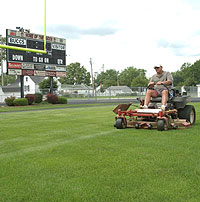 |
Good mowing practices go a long way towards better turf. |
|
6. Topsoil…Believe it or not, the stuff that grows a good yard or garden is not what what you want for athletic playing fields. Ideally a sub-surface that about 75% sand is ideal. It
drains better, helps resist disease and is easier to reseed come spring and summer if you have to fill in divots. Management companies like the Mercer Group specialize in what they call, “amended” soil playing fields.
7. Weeds…It’s no different than what you grow in your garden. Weeds compete for moisture, nutrients and root space. Again the disease issue comes up. According to experts, the more weeds you have the greater the risk of disease
and insects…not to mention, a field you won’t want to look at.
8. Too many kinds of grasses…What? Believe it, you can have too many good kinds of grass growing at one time on the same field. “Many fields have “poa annua” grass, or some bermuda mixed in with the bluegrass,” says Tom Mercer,
“and there can be a conflict in moisture and environmental requirements. Where “poa” needs cooler weather and more moisture during the daylight hours, the bluegrass can withstand hotter conditions and evening moisture. One can die out and leave you with a patchy
surface come fall playing season. It’s best to have one consistent grass type when at all possible.”
9. Unrealistic traffic…It may seem like stating the obvious, but a grass playing field can only stand so much. “Some schools only have one field that they have to use for football, soccer, band practice and whatever else they do,”
says Mercer. “In some cases you have to come to a decision if you want a good surface… of cutting back on the amount of use, or going to an artificial surface like they’ve done in some areas, specifically Cincinnati and Columbus.” |
|
|
|
| |
|
